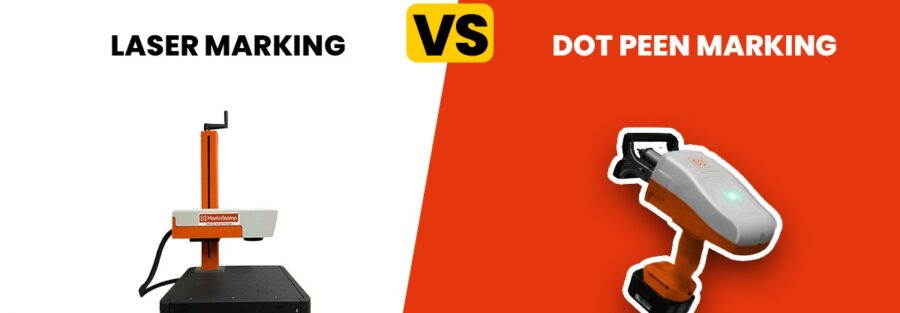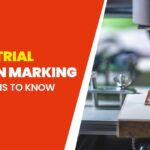Product identification, traceability, and regulatory compliance are essential to business today. Two market leaders, dot peen marking and laser marking, are dominating the industry with the respective benefits for specific industries and applications. Understanding how they stack up is important to making the correct choice for your business. In this article, we will explore more about Laser and Dot Peen Marking Machines.
What Are Laser and Dot Peen Marking Machines?
Laser Marking Machines utilise a concentrated beam of laser to modify the surface of an object, leaving permanent marks through discolouration, engraving, or ablation. It is non-contact, accurate, and operates on various materials such as metals, plastics, ceramics, glass, etc.
Dot Peen Marking Machines (pin marking or stylus marking) utilise a hard stylus pneumatically or electromagnetically driven, which hits the material surface and produces a sequence of indented dots. The dots are applied in the formation of characters, logos, or 2D codes. Dot peen is particularly useful since it is hard and can mark hard materials.
What Sets Laser and Dot Peen Apart in Mark Creation?
While both machines offer permanent marking, their methods, outcomes, and practical applications differ in several important ways. Here’s how they compare:
Marking Method
- Laser marking applies a focused beam to heat, colour, or evaporate the surface without physically contacting the material. It thereby reduces physical damage or contamination potential and is therefore best applied to cleanrooms and sensitive uses.
- Dot peen marking is based on a mechanically driven stylus striking the surface and leaving permanent marks by repeated shocks. It is a complex technique, but it produces extremely low stress and accumulates dust in the indents.
Marking Depth
- Laser marking leaves superficial impressions, in microns, but can be programmed for engraving deeper by increased levels of power output.
- Dot peen marking produces deeper, more tactile marks that are exceptionally wear-resistant and suitable for abrasion-wearing parts or extreme environments.
Mark Appearance
- Laser marks are tidy, crisp, and very readable, and can accommodate a range of fonts, logos, and fine detail graphics.
- Dot peen marks are a collection of dots and create a rougher, less polished finish. They could be functional but less appropriate for cosmetics or branding applications.
Material Impact
- Laser marking is contactless and therefore does not stress or distort the material, and is safe on sensitive or coated products.
- Dot peen marking involves minimal mechanical stress and can lead to chipping on painted surfaces. Contamination may also be trapped in dents, which, with sanitary industry use, may be less than ideal.
Speed of Marking
- Laser marking is quicker, particularly for accurate or high-volume work, and thus better suited to automated production lines.
- Dot peen marking is slower across the board, but especially for large or complex marks, though it can be well-suited to shallow, simple engravings.
Noise Level
- Laser marking is silent, advantageous in noise-critical applications.
- Dot peen marking is noisy through the repeated impacts of the stylus, and may need soundproofing in specific applications.
Maintenance Requirements
- Laser marking systems require low maintenance, no consumable replacement, and negligible component wear.
- Dot peen systems are replaced with stylus and other moving parts on an interval cycle, particularly for marking complex substances.
Suitability for Barcodes and Data Matrices
- Laser marking is the best in producing small, compact, and readable barcodes and data matrices, even after surface treatment.
- Dot peen marking can produce 2D codes, but they are less readable and smaller, therefore less appropriate for applications where high-res codes are necessary.
Where Are These Technologies Commonly Used?
Both technologies find their place in specific industries based on their strengths. Here’s where they excel:
Laser Marking Machines:
Laser marking is favoured in industries where precision, aesthetics, or cleanliness matter:
- Medical Equipment (clean, sterile marking)
- Aerospace (traceability, lightweight components)
- Electronics (minor, precise marks on small components)
- Automotive (VINs, branding, compliance marks)
- Jewellery & Gifts (decorative, elaborate patterns)
Dot Peen Marking Machines:
Dot peen machines are ideal for heavy-duty, high-durability marking in tough environments:
- Heavy Engineering (deep, permanent marks on heavy parts)
- Oil & Gas (hardware for hostile environments)
- Automotive (engine blocks, frames)
- Defence (armour components, munitions)
- Metal Fabrication (structure parts, tools)
Which Marking Solution Is Right for Your Business?
Your ideal marking solution depends on several factors: product type, operating environment, production speed, compliance needs, and budget. Here’s a quick breakdown to guide your decision:
Choose Laser Marking if you need:
- High-speed and high-precision marking with contactlessness
- Marking on a broad range of materials, such as sensitive or coated surfaces
- Small font, high-resolution graphics, or complex barcodes
- Low maintenance and quiet operation
- Cleanroom or hygiene suitability
Choose Dot Peen Marking if you need:
- High-end deep and long-lasting marks that are durable enough for heavy wear
- Low-cost plastics or hard metal marking
- Alphanumeric labelling or easy 2D marking
- Where minimal surface noise and stress are of little concern
- Lower cost of capital and abusive industrial application
Conclusion
Dot peen and laser marking machines are both permanent, safe part identification, but their advantages serve different purposes.
Laser marking is stunning in precision, versatility, and productivity and thus becomes the choice for high-technology, high-production, or sanitation-critical applications. Dot peen marking is still ordered in heavy-duty applications that demand deep, merciless marks on a lower initial investment. Think of your ingredients, mark the requirements, the production rate, and the cost to choose MarknStamp that will carry forward your business.
FAQs
1. Can laser marking machines mark all types of metals and plastics?
Yes, laser marking machines will mark most metals and an overwhelming majority of plastics correctly.
2. Are dot peen marks permanent and resistant to wear?
Yes, dot peen marks are deeply impressed, and therefore are very durable and abrasion-resistant, heat-resistant, and chemical-resistant.
3. Which marking method is better for high-speed production lines?
Laser marking is generally faster and more appropriate for high-speed, computer-controlled production lines with high-speed precision marking requirements.
4. Do dot peen marking machines require frequent maintenance?
Yes, dot peen machines do require maintenance, particularly stylus replacement, as a stylus experiences mechanical wear through continuous use.




